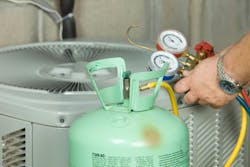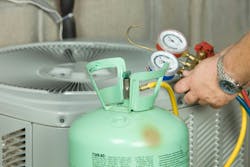Eight Ways to Stay in Step with New EPA Refrigerant Use and Reuse Regulations
In late September the U.S. EPA announced a final rule establishing the Emissions Reduction and Reclamation (ER&R) program under the American Innovation and Manufacturing (AIM) Act of 2020. The final rule will work to manage the reuse of hydrofluorocarbons (HFCs) and HFC substitutes and advance three main objectives: maximizing refrigerant reclamation, minimizing release of HFCs from equipment, and ensuring the safety of technicians and consumers.
This development will subject the HVACR industry to requirements related to leak detection and repair and refrigerant reclamation and reuse. Now more than ever it’s important for members at every level in the industry to employ a strong refrigerant management strategy. Structuring your strategy around the following “Eight Rs” can help ensure your business is aligned with the latest regulations and has the resources necessary to continue servicing equipment with legacy refrigerants as well as to successfully introduce A2L solutions to customers.
Regulations. Whether you’re manufacturing, installing, or servicing equipment, keeping up to date with regulatory changes is key to compliance. In addition, because regulatory changes will impact both legacy and new-generation refrigerants and equipment, understanding changes offers an important tool for planning for what’s next.
Recordkeeping. Regulatory bodies conduct audits—relying heavily on recordkeeping and reporting—to ensure compliance. This will mainly impact manufacturers, importers, and equipment owners. However, accurate and consistent recordkeeping on the contractor side can prove to be incredibly beneficial to your business’s operating efficiency, bring added value to your customers, and support sustainability objectives.
Repair leaks. Practicing consistent, effective leak detection and repair is an important part of regulatory compliance that can also impact your bottom line by reducing service gas costs and keeping systems operating at peak efficiency. In addition, it’s the first line of defense in reducing HVACR systems’ impact on the environment.
Replace equipment. As systems approach the end of their serviceable lifetime, define which new, higher-efficiency units utilizing A2L refrigerants offer the best replacements. Remind customers of benefits such as reduced energy consumption and operating costs.
Retrofits. If equipment is in good condition and not nearing the end of its serviceable lifetime, it may still make sense, where applicable, to perform a refrigerant conversion, allowing it to operate with a more sustainable and readily available refrigerant.
Recovery. The first step in supporting refrigerant circularity, recovery means removing refrigerant from a system and placing it into a separate container. During this process it’s important to maintain its value/purity as much as possible by not mixing gases.
During the refrigerant recovery process, it’s important to maintain refrigerant's value/purity as much as possible by not mixing gases.
Reuse/Recycle. This means returning recovered refrigerant to the same system, or another system with common ownership. Removing oil, moisture, or other contaminants via minor “cleanup” or filtering of the recovered gas may be part of the process.
Reclamation. Reprocessing recovered refrigerant to meet approved industry purity specifications allows it to be reintroduced commercially for industry use and is becoming increasingly important in ensuring ample legacy refrigerant supply exists to meet current servicing needs. In the US, reclamation must be performed by EPA-certified reclaimers.
Conclusion
The above steps offer insights on best practices to help guide refrigerant management at your business. To ensure compliance with regulations, proper steps should be taken—starting with a thorough review and understanding of specific definitions and requirements as outlined by the US EPA and any applicable state/local agencies, and consulting with your regulatory and technical experts before acting or refraining from acting when it comes refrigerant use and reclamation. The EPA Emissions Reduction and Reclamation Program provides strong incentive for HVACR contractors and equipment owners/operators to design and implement their refrigerant management strategies. Additional motivations include the industry’s transition to A2Ls being well underway, the need for companies industrywide to help ensure sufficient supply of phase-downed legacy refrigerant and supporting the industry in reducing its impact on the environment.
Moreover, adhering to the “Eight Rs” can keep your company in great position to maintain, and possibly grow, your business.
Dr. Charles “Dr. Chuck” Allgood holds a PhD in chemistry, has more than 30 years of experience in the HVACR industry, and is a respected speaker at many industry events. In addition to Chemours, he’s worked for the National Institute of Standards and Technology.
About the Author
Charles Allgood
Technical Fellow with Chemours
Charles “Dr. Chuck” Allgood holds a PhD in chemistry, has more than 30 years of experience in the HVACR industry, and is a respected speaker at many industry events. In addition to Chemours, he’s worked for the National Institute of Standards and Technology. Dr. Allgood has held a variety of research, development, business, technical service, training, and applications development positions with Chemours. Most recently, he has focused on the development of low-GWP refrigerants—including Chemours Opteon™ brand refrigerants—and educating industry professionals about the changing regulatory landscape and A2L refrigerants on the market.


